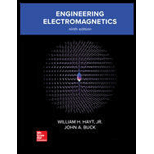
Concept explainers
The solution of Laplace' equation.
Answer to Problem 6.43P
The potential field
Explanation of Solution
Calculation:
The Poisson's equation (generalization of Laplace equation) is defined for
The Poisson's equation is written as
Here,
Simplify equation (1) as,
Integrate equation (2) with respect to spherical coordinate
Substitute
Simplified the equation (4) as,
The Laplace's equation is defined for
The Laplace's equation is written as
Integrate the equation (5) with respect to spherical coordinate
Equation (6) is multiplied with
If equation (6) and equation (7) is equal, then it is written as
Simplified the equation (8) as,
Substitute
At boundary condition
Substitute
Simplify equation (12) as
Integrate the equation (3) with respect to
Substitute
Simplify equation (14) as
Integrate the equation (10) with respect to
Substitute
Equation (16) is simplified as
Substitute
Substitute
If equation (17) and equation (18) is equal, then it is written as
Substitute
Substitute
Substitute
The value of potential difference
Substitute
Substitute
Conclusion:
Therefore, the potential field
Want to see more full solutions like this?
Chapter 6 Solutions
Engineering Electromagnetics
- 2. Triple Integral Applications 2a. First step Darw the volume of the solids in the first octant which bounded by xy-plane, yz-plane, plane x+y=4 and z. = x2+6. 2b. First draw the region bounded in between z = p and z=1, side by the cylinder r? ≤ 4, and in the first and second octant. Defermine its volume by using cylindrical coordinate system. 2c. Solving Using Spherical Coordinates 2c. First draw the volume of region which is bounded above by sphere of x? + y2 + 2? = 81 and below by cone z = x? + y? in the first octant. first step drawing second step calculation i need to cal by handarrow_forwardArmature reaction in an alternator primarily affects: A: rotor speed B: terminal voltage per phase C: frequency of armature current D: generated voltage per phasearrow_forwardAs the load of a 3-phase synchronous motor increases, the speed: a: Decreases b: Increases c: Does not change d: Increases then decreasesarrow_forward
- configuration to Q2: Design bio-electronics circuit using two inverting an operation-amplifier produce the output voltage Vo=10V1-8V2-0.8V3+12V4 choose RF-100KQ2. What's the type circuit.arrow_forwardconfiguration to Q2: Design bio-electronics circuit using two inverting an operation-amplifier produce the output voltage Vo-10V1-8V2-0.8V3+12V4 choose RF-100K2. What's the type circuit. [5] Marrow_forwardDon't use ai to answer I will report you answerarrow_forward
- The capacitor shown in the figure below is initially discharged. At t=0s the switch is moved to position B. Determine an expression for the voltage V across the capacitor for t≥0sarrow_forward4,57. Consider a discrete-time LTI system whose system function H(z) is given by Z H(z) Z- (a) Find the step response s[n]. 1 |z|> 2 (b) Find the output y[n] to the input x[n] = nu[n]. Ans. (a) s[n] = [2-()"]u[n] (b) y[n]=2[()" + n − 1]u[n] -arrow_forward4.56. Consider the system shown in Fig. 4-10. (a) Find the system function H(z). (b) Find the difference equation relating the output y[n] and input x[n]. Ans. (a) H(z) = + 7 -1 1+a,z+azz-2 (b) y[n]+a, y[n − 1]+a₂y[n-2]= box[n] + b,x[n − 1] + b₂x[n-2] x[n] a₂ b₂ Z-' b₁ bo Σ Σ y[n] Fig. 4-10arrow_forward
- Q1:For the network of figure, determine: 1-Av,AI,ZIN,Zo and Avs. if hie-1.8KQ, hre=2*10-4, hfe-120 and hoe-25μs. 2-S(Ico),S(VBE),S(ẞ) using T₁ as the temperature at which the parameter values are s and ẞ(T2) as 20% more than ẞ(T1). の 3-Determine the net change in Ic if a change in operating condition results in Ico increa 0.2μA to 10uA,VBE drops from 0.7 to 0.6 and ẞ increase 20%. 4-Find the change in Ic if the temperature increase from 20 to 80 [C] +16 3 kohm 220 kohm 20 MF Ikohm HOME HE 120 mv B4= www B 12 kohm 200 ohm Ikohm 20MF 10arrow_forward4.55. Consider the system shown in Fig. 4-9. Find the system function H(z) and its impulse response h[n]. 1 Ans. H(z) = 1- ½-1 h[n] = { } }) un u[n] x[n] + Σ Fig. 4-9 y[n]arrow_forwardDon't use ai to answer I will report you answerarrow_forward
 Introductory Circuit Analysis (13th Edition)Electrical EngineeringISBN:9780133923605Author:Robert L. BoylestadPublisher:PEARSON
Introductory Circuit Analysis (13th Edition)Electrical EngineeringISBN:9780133923605Author:Robert L. BoylestadPublisher:PEARSON Delmar's Standard Textbook Of ElectricityElectrical EngineeringISBN:9781337900348Author:Stephen L. HermanPublisher:Cengage Learning
Delmar's Standard Textbook Of ElectricityElectrical EngineeringISBN:9781337900348Author:Stephen L. HermanPublisher:Cengage Learning Programmable Logic ControllersElectrical EngineeringISBN:9780073373843Author:Frank D. PetruzellaPublisher:McGraw-Hill Education
Programmable Logic ControllersElectrical EngineeringISBN:9780073373843Author:Frank D. PetruzellaPublisher:McGraw-Hill Education Fundamentals of Electric CircuitsElectrical EngineeringISBN:9780078028229Author:Charles K Alexander, Matthew SadikuPublisher:McGraw-Hill Education
Fundamentals of Electric CircuitsElectrical EngineeringISBN:9780078028229Author:Charles K Alexander, Matthew SadikuPublisher:McGraw-Hill Education Electric Circuits. (11th Edition)Electrical EngineeringISBN:9780134746968Author:James W. Nilsson, Susan RiedelPublisher:PEARSON
Electric Circuits. (11th Edition)Electrical EngineeringISBN:9780134746968Author:James W. Nilsson, Susan RiedelPublisher:PEARSON Engineering ElectromagneticsElectrical EngineeringISBN:9780078028151Author:Hayt, William H. (william Hart), Jr, BUCK, John A.Publisher:Mcgraw-hill Education,
Engineering ElectromagneticsElectrical EngineeringISBN:9780078028151Author:Hayt, William H. (william Hart), Jr, BUCK, John A.Publisher:Mcgraw-hill Education,





